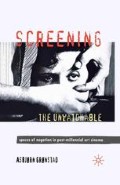Abstract
This book began its life under the title “Illicit Images.” Having recently written a study of the interrelation between violence and aesthetics in American cinema, I next wanted to study (mostly) European art cinema and the particular strand within it that gravitated toward highly controversial, even extreme, representations of the body, of violence and of sexuality. In my mind, the term “illicit” suggested itself as an evocative phrase for the kind of subject matter that I was interested in; that is, until a colleague rather helpfully pointed out that the relevant films were all actually “licit.” It was not as if I was under any delusion that copies of, say, Baise-moi or Anatomy of Hell cold only be obtained on the black market, like snuff items; so what could possibly account for my thinking of such films in terms of the illicit? First of all, I realized that it was, to some extent, a case of domain conflation; there had been some leakage from the realm of the depicted onto the realm of the depiction. Clearly, some of the acts found in my corpus of films would be defined as illicit had they occurred in real life. But that was not the whole story. Notable, also, was the sense in which some of these films’ images made their violent disruptions experientially palpable as sensorial and cognitive assaults. One could perhaps be forgiven for misconstruing something that was capable of eliciting so much distress as forbidden wares.
Access this chapter
Tax calculation will be finalised at checkout
Purchases are for personal use only
Preview
Unable to display preview. Download preview PDF.
Notes
David MacDougall, The Corporeal Image: Film, Ethnography, and the Senses, Princeton: Princeton University Press, 2006, 3.
Wayne Booth, The Company We Keep: An Ethics of Fiction, Berkeley: University of California Press, 1988, 17.
André Bazin, “Marginal Notes on Eroticism in the Cinema,” What is Cinema? Volume 2 [1971], trans. Hugh Gray, Foreword by François Truffaut, new Foreword by Dudley Andrew, Berkeley: University of California Press, 2005, 175.
Quoted in Brian McNair, Striptease Culture: Sex, Media and the Democratisation of Desire, London: Routledge, 2002, 174.
Anthony Julius, Transgressions: The Offences of Art, London: Thames & Hudson, 2002, 10.
Asbjørn Grønstad, Transfigurations: Violence, Death and Masculinity in American Cinema, Amsterdam: Amsterdam University Press, 2008, 188.
For an alternative conceptualization of the transgressive in relation to visuality, see Ingeborg Reichle and Steffen Siegel, eds, Maßlose Bilder: Visuelle Ästhetik der Transgression, München: Wilhelm Fink Verlag, 2009. In this anthology the visually transgressive, associated with notions of immoderation and invisibility, seems bound up less with normative than with epistemological questions.
Lesley Stern, “The Body as Evidence,” The Sexual Subject: A Screen Reader in Sexuality, ed. Screen, London: Routledge, 1992, 215.
For a discussion of transparency as a formal effect, see in P. Adams Sitney, Eyes Upside Down: Visionary Filmmakers and the Heritage of Emerson, Oxford: Oxford University Press, 2008, 275.
Paul de Man, The Resistance to Theory, Foreword by Wlad Godzich, Minneapolis: University of Minnesota Press, 1986, 10.
Martine Beugnet, Cinema and Sensation: French Film and the Art of Transgression, Edinburgh: Edinburgh University Press, 2007, 68.
See for instance Alfred Gell, Art and Agency: An Anthropological Theory, Oxford: Clarendon Press, 1998; Hans Ulrich Gumbrecht, Production of Presence: What Meaning Cannot Convey, Stanford: Stanford University Press, 2004; W. J. T. Mitchell, What Do Pictures Want? The Lives and Loves of Images, Chicago: University of Chicago Press, 2005; and Georges Didi-Huberman, Confronting Images: Questioning the Ends of a Certain History of Art, trans. John Goodman, University Park, PA.: Pennsylvania State University Press, 2005. As an aesthetic movement Dogme 95 has for instance been seen as presentational rather than representational. See Anne Jerslev, “Dogma 95, Lars von Trier’s The Idiots and the ‘Idiot Project’” Realism and “Reality” in Film and Media, ed. Anne Jerslev. Copenhagen: Museum Tusculanum Press, 2002, 48.
See Gilles Deleuze, Cinema 2: The Time-Image [1985], trans. Hugh Tomlinson and Robert Galeta, Minneapolis: University of Minnesota Press, 1989, 168. See also Cesare Casarino, “David Wojnarowicz, AIDS, and the Cinematic Imperative,” Raritan, 20.4 (2001): 148. Mieke Bal has also suggested that certain works of art may have the status of “theoretical objects.” See Mieke Bal, Quoting Caravaggio: Contemporary Art, Preposterous History, Chicago: University of Chicago Press, 1999, 5.
See W. J. T. Mitchell, Picture Theory: Essays on Verbal and Visual Representation, Chicago: University of Chicago Press, 1994, 82; Kaja Silverman, The Threshold of the Visible World, New York: Routledge, 1996, 5; and D. N. Rodowick, Reading the Figural, or, Philosophy After the New Media, Durham: Duke UP, 2001.
Siegfried Kracauer, Theory of Film: The Redemption of Physical Reality, London: Oxford University Press, 1960, 58.
Michael Haneke, “Film als Katharsis,” Austria (In) Felix: Zum Österreichischen Film der 80er Jahre, ed. Francesco Bono, Graz: Edition Blimp/Rome: Aiace, 1992, 89.
Christopher Sharrett, “The World that is known: Michael Haneke interviewed,” Kinoeye: New Perspectives on European Film, 4:1 (2004), par. 18. http://www.kinoeye.org/04/01/interview01.php
Copyright information
© 2012 Asbjørn Grønstad
About this chapter
Cite this chapter
Grønstad, A. (2012). Introduction. In: Screening the Unwatchable. Palgrave Macmillan, London. https://doi.org/10.1057/9780230355859_1
Download citation
DOI: https://doi.org/10.1057/9780230355859_1
Publisher Name: Palgrave Macmillan, London
Print ISBN: 978-1-349-32064-6
Online ISBN: 978-0-230-35585-9
eBook Packages: Palgrave Media & Culture CollectionLiterature, Cultural and Media Studies (R0)

